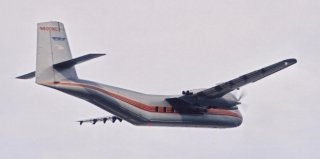You’ve Probably Never Heard of the Army's Amazing Little Airlifter
Cute and powerful.
The silver-painted cargo plane appeared suddenly, zooming at 100 miles per hour, just 150 feet over the mountaintop. A U.S. Army outpost was on that mountain in Marzak, located in eastern Afghanistan’s restive Paktika province.
Twin engines roaring, the Turbo Caribou airlifter—registration number N238PT—pulled up sharply. Pallets of food, fuel and equipment slid out of the cargo hold. Parachutes unfurled, slowing the pallets as they tumbled onto the drop zone.
Then the Turbo Caribou droned away.
That airdrop in January 2012 was incredibly fast and precise—and it had to be. With its violent and unpredictable weather and rugged terrain, not to mention all the Taliban fighters on the hillsides, Paktika is a dangerous place.
The same conditions that make aerial resupply so treacherous also make it utterly necessary. There aren’t many other ways to get supplies up onto those mountaintops.
And there aren’t many airplanes that can pull off the so-called “low-cost, low-altitude” airdrops that are best at quickly depositing stuff on a tiny drop zone on the top of a mountain.
In 2012 there were just two Turbo Caribous in all the world, both the products of a years-long effort by PEN Turbo, a small aviation firm working out of a World War II hangar in Cape May, New Jersey.
Soon there were four Turbo Caribous, although one was lost in a 2016 crash. In the spring of 2018 PEN Turbo completed the conversion of the Caribou with the serial number N302PT.
PEN Turbo takes old De Havilland Canada Caribou cargo planes—the design dates back to the late 1950s—and swaps out their obsolete Pratt & Whitney R2000 piston engines for Pratt & Whitney Canada PT6A-67T turbine powerplants.
PEN Turbo converted its first Caribou, registration number N600NC, in the late 1990s and the N238PT in 2010. The old Caribou is a great basis for a new plane. “Simply put, it’s a tough, simple and (as a test engineer put it after his first flight) a ‘very buoyant’ aircraft,” says Goby Gobalian, who co-founded PEN Turbo with pilot Hart.
“Conversion to turbine powerplant offers improved [short-takeoff and landing] performance, much lower long-term costs of ownership and, of course, turbine reliability,” PEN Turbo explains on its Website.
The Turbo Caribou’s maximum payload is five tons. The plane “is well suited for delivery missions to remote locations,” according to Flightworks, one of two American companies that each operates a single Turbo Caribou, flying tough resupply missions for government and civilian clients.
“The genesis of the Turbo Caribou started in northern [British Columbia] and the Yukon in the early ’80s,” Gobalian says. “Bob Ambrose, probably one of the finest bush pilots around, operated a Caribou that I used to suffer keeping flying, that’s where I got the idea and started working to make the Turbo Caribou a reality.”
They named their company after Perry E. Niforos, who died in the 1992 crash of an earlier turboprop Caribou converted by a different firm, NewCal Aviation. At that time, swapping the engines on a single Caribou cost around $4 million.
In 2011, the U.S. Army was deploying more troops in eastern Afghanistan along the border with Pakistan, in an effort to intercept Taliban crossing between the two countries. These extra troops found themselves in remote places like Marzak, where the military’s own aircraft couldn’t easily go.
So the Army hired Flightworks. The company sent fifteen staff and its single Turbo Caribou to Bagram airfield in October 2011. By early 2012 the Turbo Caribou had delivered a million pounds of cargo to Marzak and other remote outposts.
“We can drop to more than one location on the same flight, so we can go to one place and drop two or three bundles, go to another place drop two or three more bundles and then come home,” John Early, one of Flightworks’ pilots, said in August 2013.
Early left Flightworks some time after that and joined Rampart Aviation, which flies one of the other Turbo Caribous. Since its conversion in 2000, that plane had passed between several operators. In 2010, it delivered relief supplies to earthquake-ravaged Haiti on behalf of the United Nations.
The third Turbo Caribou belonged to the Puncar Regency Administration in Indonesia. It arrived in September 2016 and, a month later, on Oct. 31, crashed into a mountainside while on an unscheduled cargo flight. Tragically, the four crew died.
It’s not clear if PEN Turbo has already lined up a buyer for its fourth Turbo Caribou. But it’s hard to imagine somebody won’t want one of the world’s best—and rarest—airlifters.
David Axe is defense editor at The National Interest. He is the author of the graphic novels War Fix, War Is Boring and Machete Squad.
Image: Penturbo

